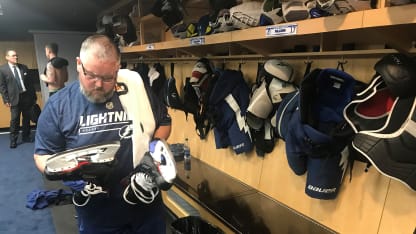I'm inside the windowless cargo area of a box truck bouncing through the streets of downtown Buffalo, situated on a makeshift seat Jason Berger has graciously carved out of a pile of hockey bags.
Our destination is Buffalo's KeyBank Center, the home of the Buffalo Sabres. It's four in the afternoon. The Tampa Bay Lightning have just arrived in Western New York via charter plane on a Friday for their game against the Sabres Saturday. Normally, after deplaning, I would join the team and staff members on a bus bound for the team hotel.
But this trip, I'm following around the team's equipment staff for a behind-the-scenes look at what their job entails and everything that goes into getting a hockey team ready to play, from city to city, night after night. 82 regular season games plus preseason, postseason and all stops in between.
The team behind the team: Setting up in Buffalo
In the first installment of a three part series, Bryan Burns finds out what it takes to travel with the Lightning equipment staff

Thursday, the Lightning were finishing a mini homestand against the Carolina Hurricanes with a 3-1 victory. Friday, they're traveling to Buffalo. Saturday, they'll play the Sabres, pack up all their gear right after the game and fly out to Brooklyn for a contest against the New York Islanders on Sunday, two games in a span of roughly 24 hours known in the league as a back-to-back.
Berger is part of a three-man equipment staff for the Lightning headed by equipment manager Ray Thill (Razor). Berger and Rob Kennedy (Bubba) are assistants [for the purposes of this story, staffers will be referred to by their nickname, since that's how they're known around the team].
A Buffalo equipment assistant named Keith meets us at the airport with the Sabres' equipment truck. As ground crew at the airport unload the hockey bags and crates the team takes on every road trip onto a conveyor belt that empties into the back of the box truck, where Keith and Berger are stacking, Bubba explains every team has equipment guys for the road teams. They help the visitors load and unload all of their equipment when they come into the arena, get the visiting team situated in the arena they'll call home for the next 24 hours and work hand-in-hand with the Lightning equipment staff to make sure the team has everything it needs during its stay. In Tampa, Rod Harris, who has been with the organization since its inaugural season in 1992-93, and Paul Brace, a former staffer for the Tampa Bay Storm who slid over to the Lightning when the Storm ceased operations, handle the visiting teams.
"We're pretty friendly with all the teams' road guys," Bubba says. "It's like a fraternity."
With the gear loaded, it's time to head to the rink.
Except there's a problem.
The cab of the Sabres' truck doesn't have enough seats for all of us. There's Keith, myself, Razor, Bubba and Berger, plus assistant athletic trainer Mike Poirier (Mikey) and assistant strength and conditioning coach Brandon Rodgers.
Berger looks at me and smiles.
"Come on and hop in the back with me," he says.
---
Somewhere along Route 33 as the box truck travels the 20 minutes to the arena, right around the time my motion sickness kicks in and I start to regret eating that second crab cake on the plane (which is why I'm now sitting), Berger tells me how he got here, right now here being standing wedged between the roll-up door of the truck and a pile of hockey bags stacked 10 feet high to the ceiling, pushing against the bags as the truck blindly turns right or left or takes off abruptly to keep them from knocking him over and piling on top.
Berger is a Philadelphia native and comes to the Lightning from Providence, where he was the head equipment manager of the Bruins AHL team. Prior to that, he worked with the Florida Everblades in the ECHL, where he got to know Razor and Bubba when the Lightning would travel to Germain Arena for their annual training camp week in Naples.
When Berger heard there was an opening on the Lightning equipment staff prior to the 2017-18 season, he sent Razor a cover letter and his resume.
Later that night, he received a phone call.
It was Razor.
"Why am I sitting on my couch reading your resume right now?"
Berger was hired soon after.
His enthusiasm for his work is contagious. In a position that demands a lot of manual labor, a lot of time on the road away from friends and family and a constant lack of sleep, Berger tackles his job with gusto. It's rare to see Berger without a smile on his face.
"Living the dream," he says. "Every day I get to go to work inside a NHL arena. How cool is that?"
The truck slows to a stop and suddenly we're moving in reverse, the truck's back-up beeps giving it away.
"We're at the arena now," Berger says. "You'll feel the bump when we hit the loading dock and then it's time to go to work."
We wait in silence a few seconds and then…BUMP
I'm grateful. Wasn't sure how much longer those crab cakes were going to stay down.
---
Just about the time the team, coaches and staff are checking into their hotel rooms, the equipment staff begins the unload at the arena.
The unload is what it sounds like. All the equipment that's made the trip from Tampa has to be taken off the box truck and set up inside the locker room and the surrounding ancillary rooms (training room, coaches' room, etc.). There are player hockey bags weighing about 25 to 30 pounds each stacked high on rolling carts and pushed to the locker room. There are crate boxes on wheels -- a seemingly never-ending chain - ranging in size from a small dorm room refrigerator to an airplane serving cart, boxes that hold everything from medical supplies and replacement skate laces to bubble gum and a medium-size stereo speaker (that win song you like watching so much on social media? Here's where it plays).
I'm going off memory, but I'd say there are probably at least 30 of these rolling crate boxes.
Surely all this stuff isn't necessary.
"It's better to have something than not have it," Berger says. "We bring everything we think we might need."
It seems like a lot.
"You guys are actually one of the lighter teams in the league," Keith adds. "Some teams bring a lot more."
Inside the visitors' locker room at KeyBank, Bubba and Razor are setting up the equipment in each player's stall, starting with the goaltenders. Each piece is meticulously placed in a certain spot inside the stall: pants on a hook, gloves in the cubby, helmet on top. Sticks are lined up in the hallway and taped together in numerical order, starting with Girardi (No. 5). Mikey sets up the medical room. Brandon sets up the change room (where the players keep their suits they wear while traveling). For this unload, head athletic trainer Tom Mulligan (Mully) and massage therapist Christian Rivas (Papi) are helping out, which they do whenever the hotel is walking distance to the rink. Mully is unloading sticks. Papi sets up his massage area. Berger is setting up the coaches' room.
In the Lightning locker room at AMALIE Arena, players keep the same stall throughout the season, often the same one throughout their entire tenure with the organization.
How is it determined where they sit on the road when locker rooms have different sizes and layouts?
Bubba has an Excel file, he says, of every visiting room in the league.
"It's more useful in the playoff," he says.
If you're in a playoff series and you win the first game of the two games in the opposing building, he explains, guys are going to want to stay in that same spot for the second game. And everything else - routines, equipment placement, schedule - must remain the same too.
A lot of the work the equipment staff does is predicated on superstition.
Bubba says he, Berger, Razor and Mikey will stay at the rink all day on gameday. They plan to be inside KeyBank around 8 a.m. the next morning to start working. Before morning skate, Razor will fix a skate and Bubba will repair an elbow pad. They'll get a bite of lunch and take a nap if they can find a quiet spot inside the arena or work on other stuff until game time.
Needless to say, it's a full day.
And it's a long one too. The team is scheduled to leave Buffalo and arrive in Newark, New Jersey after the game, and the process of unloading all the equipment from the plane to the box truck to a new arena, this time Brooklyn's Barclays Center, begins again. It's at least a 40-minute ride from Newark to Barclays and with unload time, the staff probably won't open their hotel room door in Brooklyn until at least 2:30 a.m.
Walking from the hotel to KeyBank before the game - they're connected by a parking garage you can walk through to protect yourself somewhat from the elements (it's still frigid cold, mind you) - I cross paths with Lightning goalie coach Frantz Jean. I tell him about the story I'm reporting on and how I'll be in the tunnel behind the bench for that night's game to watch the equipment staff work.
"They're the hardest-working guys in the league," he offers up unsolicited.
I'm starting to figure that out myself.


















